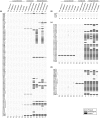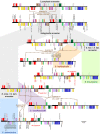Lycophyte plastid genomics: extreme variation in GC, gene and intron content and multiple inversions between a direct and inverted orientation of the rRNA repeat - PubMed (original) (raw)
. 2019 Apr;222(2):1061-1075.
doi: 10.1111/nph.15650. Epub 2019 Jan 24.
Affiliations
- PMID: 30556907
- PMCID: PMC6590440
- DOI: 10.1111/nph.15650
Lycophyte plastid genomics: extreme variation in GC, gene and intron content and multiple inversions between a direct and inverted orientation of the rRNA repeat
Jeffrey P Mower et al. New Phytol. 2019 Apr.
Abstract
Lycophytes are a key group for understanding vascular plant evolution. Lycophyte plastomes are highly distinct, indicating a dynamic evolutionary history, but detailed evaluation is hindered by the limited availability of sequences. Eight diverse plastomes were sequenced to assess variation in structure and functional content across lycophytes. Lycopodiaceae plastomes have remained largely unchanged compared with the common ancestor of land plants, whereas plastome evolution in Isoetes and especially Selaginella is highly dynamic. Selaginella plastomes have the highest GC content and fewest genes and introns of any photosynthetic land plant. Uniquely, the canonical inverted repeat was converted into a direct repeat (DR) via large-scale inversion in some Selaginella species. Ancestral reconstruction identified additional putative transitions between an inverted and DR orientation in Selaginella and Isoetes plastomes. A DR orientation does not disrupt the activity of copy-dependent repair to suppress substitution rates within repeats. Lycophyte plastomes include the most archaic examples among vascular plants and the most reconfigured among land plants. These evolutionary trends correlate with the mitochondrial genome, suggesting shared underlying mechanisms. Copy-dependent repair for DR-localized genes indicates that recombination and gene conversion are not inhibited by the DR orientation. Gene relocation in lycophyte plastomes occurs via overlapping inversions rather than transposase/recombinase-mediated processes.
Keywords: Isoetes (quillworts); Lycopodiaceae (clubmosses); Lycopodiophyta (lycophytes); Selaginella (spikemosses); evolutionary stasis; gene loss; inversion; plastid genome (plastome).
© 2018 The Authors. New Phytologist © 2018 New Phytologist Trust.
Figures
Figure 1
Functional content of lycophyte plastomes. (a) Protein‐coding genes. (b)
rRNA
genes. (c)
tRNA
genes. (d) Introns. Total counts are listed at the bottom of each functional category. Annotations for specific genes and introns that were corrected in this study are marked with a dark gray circle.
Figure 2
Structural evolution of Lycopodiaceae plastomes. The loss of trnT‐GGU is marked with a ψ. Inverted repeat (
IR
) expansions are denoted with red arrows, and genes affected by the
IR
expansion are listed in red text. The two genes arising from the split of ycf2 are labeled.
Figure 3
Structural evolution of Selaginella plastomes. Pseudogenes and lost genes are marked with a ψ and listed in black text. Inversion endpoints are marked by brown dotted lines, and the genes closest to each endpoint are listed in brown text. Inverted repeat (
IR
) expansions are denoted with red arrows, and genes affected by the
IR
expansion are listed in red text.
Figure 4
Structural evolution of Isoetes plastomes. Pseudogenes and lost genes are marked with a ψ and listed in black text. Inversion endpoints are marked by brown dotted lines, and the genes closest to each endpoint are listed in brown text. Inverted repeat (
IR
) expansions are denoted with red arrows, and genes affected by the
IR
expansion are listed in red text.
Figure 5
Substitution rate variation among lycophyte species and genes. (a) Synonymous divergence (
_d_S
) tree estimated from 51 concatenated genes that are single copy (
SC
) in all lycophytes. (b)
_d_S
tree estimated from concatenated ndhB + psbM + rps7 genes that are duplicated in Selaginella kraussiana. (c)
_d_S
tree estimated from rps4, which is duplicated in S. moellendorffii and S. tamariscina. (d) Overall divergence (d) tree estimated from four
rRNA
genes that are duplicated in all Selaginella species. Species with duplicated genes are shown in red. Terminal branch lengths for all Selaginella species are listed, and a ratio of branch lengths is given for each species in (b–d) relative to branch lengths in (a). All trees are drawn to the scale shown at bottom.
IR
, inverted repeat;
DR
, direct repeat.
Similar articles
- The Unique Evolutionary Trajectory and Dynamic Conformations of DR and IR/DR-Coexisting Plastomes of the Early Vascular Plant Selaginellaceae (Lycophyte).
Zhang HR, Xiang QP, Zhang XC. Zhang HR, et al. Genome Biol Evol. 2019 Apr 1;11(4):1258-1274. doi: 10.1093/gbe/evz073. Genome Biol Evol. 2019. PMID: 30937434 Free PMC article. - Plastid Genomes of the Early Vascular Plant Genus Selaginella Have Unusual Direct Repeat Structures and Drastically Reduced Gene Numbers.
Shim H, Lee HJ, Lee J, Lee HO, Kim JH, Yang TJ, Kim NS. Shim H, et al. Int J Mol Sci. 2021 Jan 11;22(2):641. doi: 10.3390/ijms22020641. Int J Mol Sci. 2021. PMID: 33440692 Free PMC article. - Plastome structure, evolution, and phylogeny of Selaginella.
Zhou XM, Zhao J, Yang JJ, Péchon TL, Zhang L, He ZR, Zhang LB. Zhou XM, et al. Mol Phylogenet Evol. 2022 Apr;169:107410. doi: 10.1016/j.ympev.2022.107410. Epub 2022 Jan 11. Mol Phylogenet Evol. 2022. PMID: 35031459 - Directed Repeats Co-occur with Few Short-Dispersed Repeats in Plastid Genome of a Spikemoss, Selaginella vardei (Selaginellaceae, Lycopodiopsida).
Zhang HR, Zhang XC, Xiang QP. Zhang HR, et al. BMC Genomics. 2019 Jun 11;20(1):484. doi: 10.1186/s12864-019-5843-6. BMC Genomics. 2019. PMID: 31185895 Free PMC article. - Plastid Phylogenomics and Plastomic Diversity of the Extant Lycophytes.
Chen S, Wang T, Shu J, Xiang Q, Yang T, Zhang X, Yan Y. Chen S, et al. Genes (Basel). 2022 Jul 19;13(7):1280. doi: 10.3390/genes13071280. Genes (Basel). 2022. PMID: 35886063 Free PMC article.
Cited by
- The Possible Earliest Allopolyploidization in Tracheophytes Revealed by Phylotranscriptomics and Morphology of Selaginellaceae.
Kang JS, Yu JG, Xiang QP, Zhang XC. Kang JS, et al. Mol Biol Evol. 2024 Aug 2;41(8):msae153. doi: 10.1093/molbev/msae153. Mol Biol Evol. 2024. PMID: 39101470 Free PMC article. - Phylogenomic data resolved the deep relationships of Gymnogynoideae (Selaginellaceae).
Zhao J, He ZR, Fang SL, Han XK, Jiang LY, Hu YP, Yu H, Zhang LB, Zhou XM. Zhao J, et al. Front Plant Sci. 2024 Jul 16;15:1405253. doi: 10.3389/fpls.2024.1405253. eCollection 2024. Front Plant Sci. 2024. PMID: 39081519 Free PMC article. - The complete chloroplast genome sequence of Isoetes baodongii (Isoetaceae).
Guo L, Zhai J, Gu Y. Guo L, et al. Mitochondrial DNA B Resour. 2024 May 19;9(5):667-671. doi: 10.1080/23802359.2024.2356128. eCollection 2024. Mitochondrial DNA B Resour. 2024. PMID: 38774187 Free PMC article. - Unprecedented variation pattern of plastid genomes and the potential role in adaptive evolution in Poales.
Wu H, Li DZ, Ma PF. Wu H, et al. BMC Biol. 2024 Apr 29;22(1):97. doi: 10.1186/s12915-024-01890-5. BMC Biol. 2024. PMID: 38679718 Free PMC article. - Phylogeny, character evolution, and classification of Selaginellaceae (lycophytes).
Zhou XM, Zhang LB. Zhou XM, et al. Plant Divers. 2023 Jul 20;45(6):630-684. doi: 10.1016/j.pld.2023.07.003. eCollection 2023 Nov. Plant Divers. 2023. PMID: 38197007 Free PMC article.
References
Publication types
MeSH terms
Substances
LinkOut - more resources
Full Text Sources
Miscellaneous




